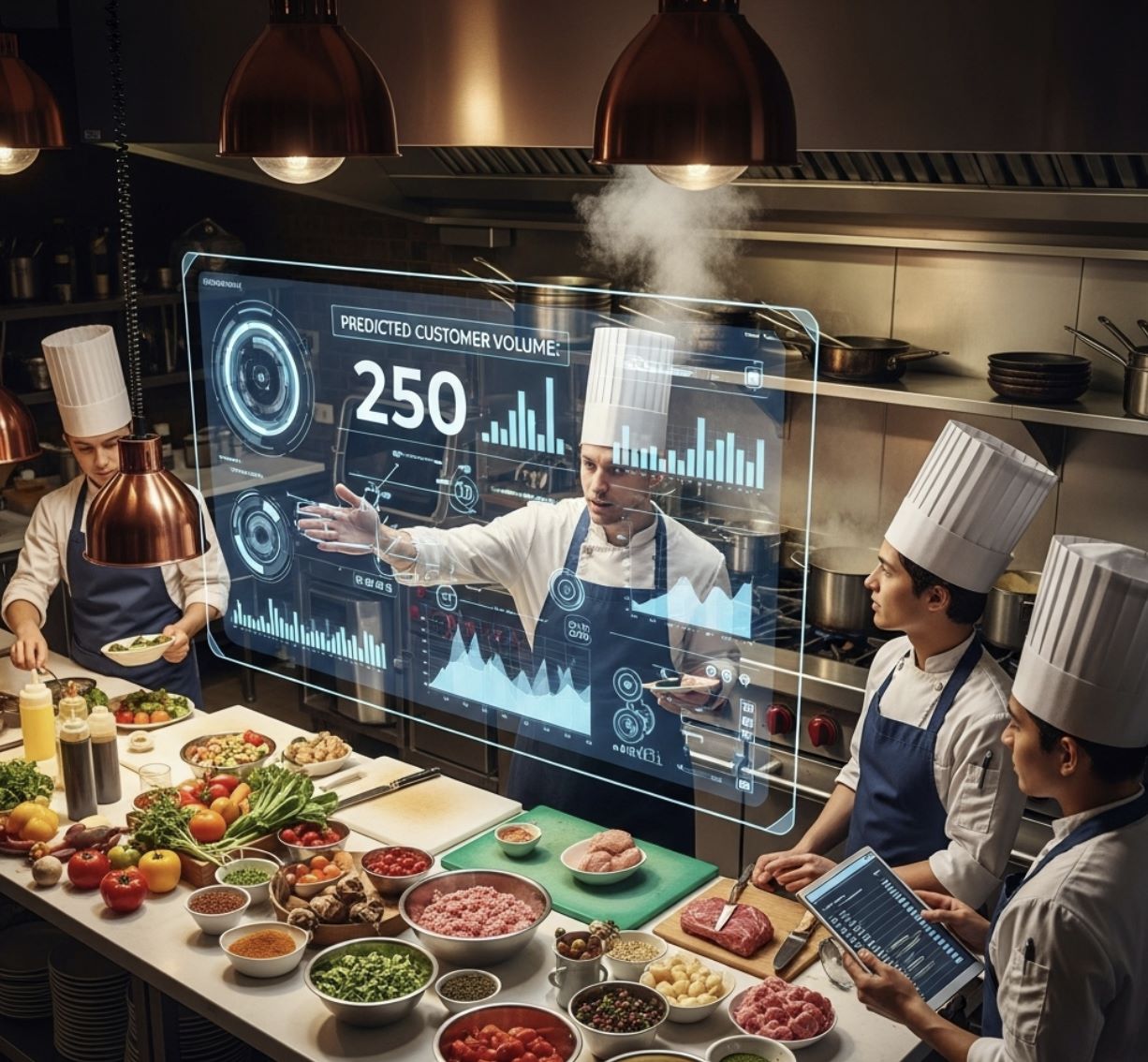AI in restaurant management & kitchen operations
Discover how AI is revolutionizing restaurant management and kitchen operations: accurate demand forecasting, advanced cooking robots, intelligent customer service, and data-driven decision-making that reduce costs and elevate the dining experience.
The restaurant industry is rapidly embracing artificial intelligence (AI) to streamline operations, improve efficiency, and enhance customer experience. According to recent market research, the global restaurant automation and food tech market has become a multi-billion-dollar industry.
Pressure from high labor costs and shortages has pushed restaurants of all sizes to invest in AI solutions that automate repetitive tasks and integrate data across systems. As one industry study notes, restaurants increasingly "use automation to streamline tasks, cut food costs, and deliver more consistent service," treating AI not as a luxury but as a new operational priority.
In practice, leading chains and startups around the world are deploying AI for everything from smart inventory forecasting to robotic cooks, reshaping how kitchens and managers operate on a global scale.
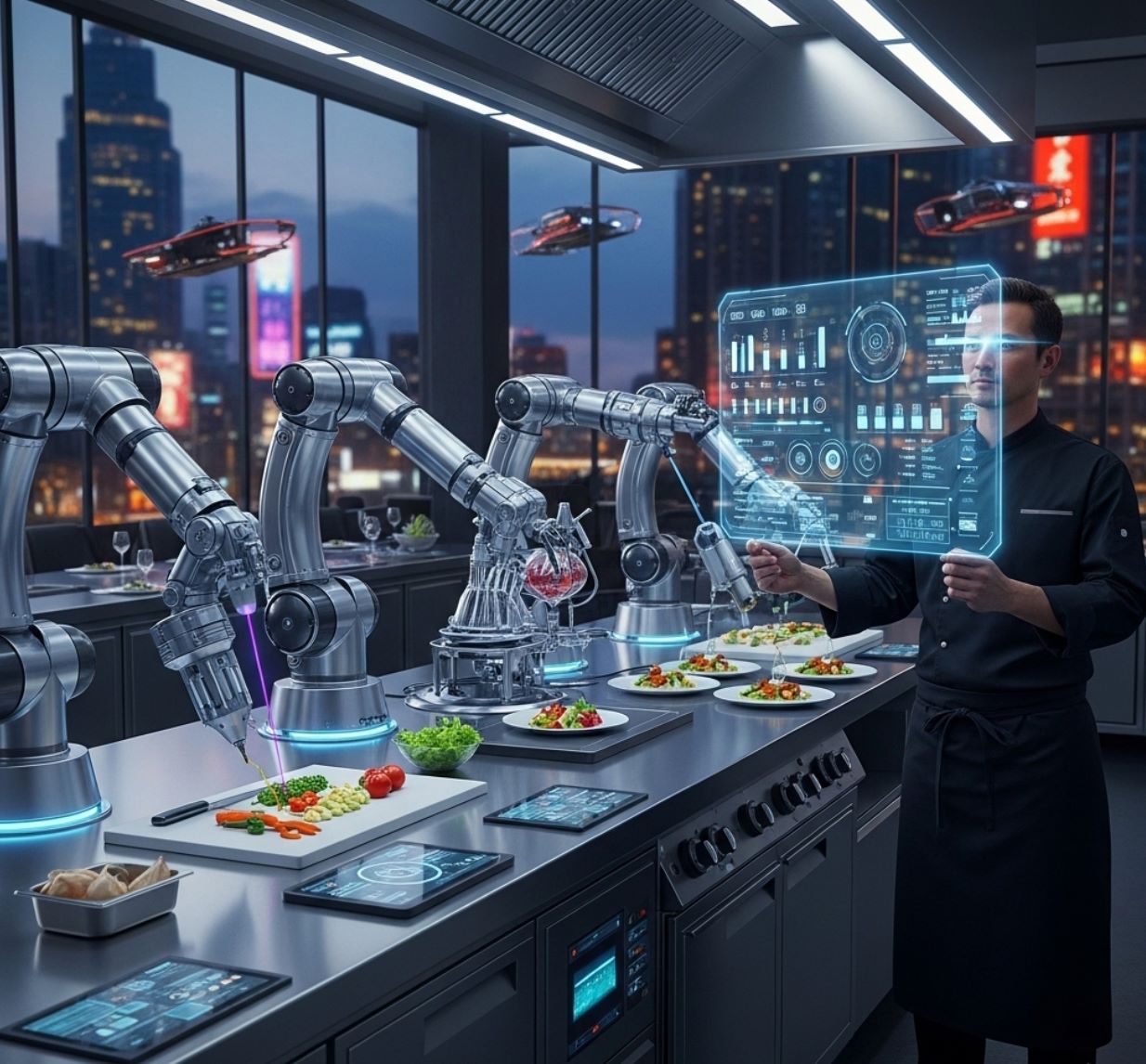
AI for Inventory, Forecasting, and Waste Reduction
A major application of AI is in inventory control and demand forecasting. Traditional restaurants often juggle overstock and shortages – leading to waste or missed sales. AI-driven forecasting systems analyze historical sales, weather, local events, and current trends to predict customer demand for specific menu items.
This allows managers to order just the right quantities of ingredients.
Waste Reduction
AI can reduce food waste by up to 20% through predictive ordering
- Smart demand forecasting
- Optimal ingredient ordering
- Minimized spoilage
Industry Adoption
55% of restaurants now use AI daily for inventory management
- Daily inventory tracking
- Demand planning
- Cost optimization
For instance, AI platforms can combine past sales data with factors like upcoming holidays or sports events to fine-tune orders and staffing levels. The impact is significant: studies report that AI can reduce food waste by up to 20% and cut costs by preventing over-ordering. One report noted that 55% of restaurants now use AI daily for inventory management and demand planning.
This predictive capability helps restaurants worldwide – from UK cafes adjusting for local events to Middle Eastern outlets adapting to seasonal holidays – to optimize stock and minimize spoilage. In short, AI turns guesswork into data-driven orders, keeping popular items in stock while slashing the amount of unused, spoiled food.
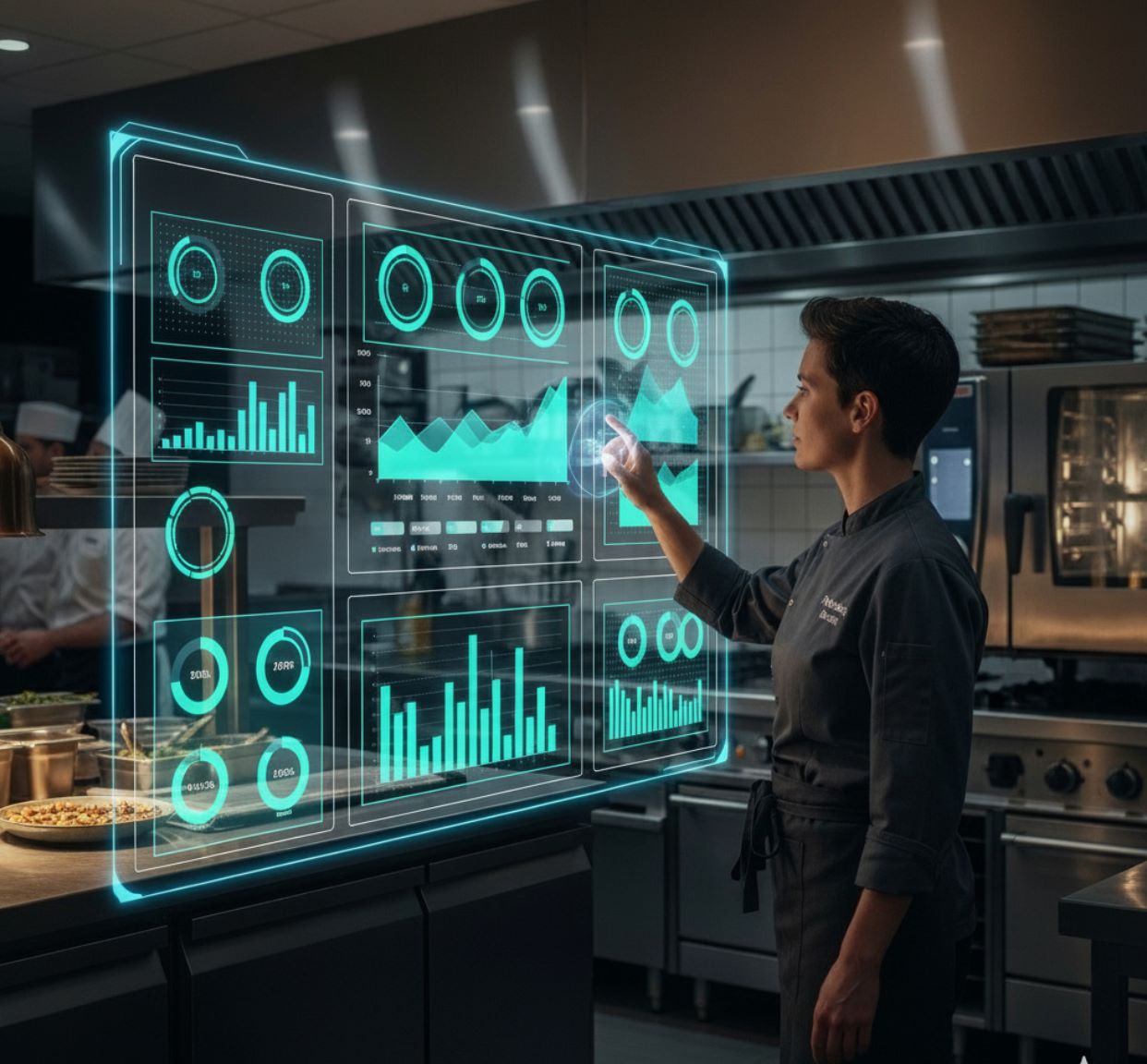
Smart Kitchen Automation and Robotics
AI is also revolutionizing kitchen operations through automation and robotics. Robots equipped with AI "brains" can perform tasks like frying, stirring, or assembling dishes with precision and consistency. For example, Miso Robotics' Flippy is an AI-powered robotic fry station now used by chains like White Castle and Jack in the Box.
Computer Vision
Next-Gen Performance
White Castle reports that Flippy has eliminated a major bottleneck at its fryer, ensuring consistent portions and freeing staff to focus on customer service. In 2024 Miso unveiled a next-generation Flippy that is 50% smaller and twice as fast as before. This new model installs in existing kitchens in hours and can handle multiple fried items.
Beyond frying, robots can cook full dishes. In Asia, Shenzhen startup Botinkit developed the Omni cooking robot. Omni can stir-fry and stew meals, seasoning automatically and even cleaning itself, all controlled through a touch-screen interface.
The operator merely selects a recipe and monitors the steps; the robot handles timing and mixing. Such technology lets even non-chefs run a kitchen line.
Botinkit's CEO reports that robots like Omni can cut labor costs by ~30% and reduce ingredient waste by about 10%, while delivering consistent dish quality as restaurants scale up.
Fast-casual chains are also adding automation. Sweetgreen's first automated location hit $2.8 million in sales with a 31.1% profit margin, while employee turnover was 45% lower than typical stores.
— Sweetgreen Performance Report
Fast-casual chains are also adding automation. Sweetgreen (a U.S. salad chain) introduced an "Infinite Kitchen" with conveyor belts and robotic assembly. Its first location saw higher throughput and profits: in one year it hit $2.8 million in sales with a 31.1% profit margin.
- Employee turnover was 45% lower than a typical store
- Automated kitchens generated 10% higher customer checks
- Faster order completion and improved accuracy
- Repetitive tasks were automated, improving job satisfaction
The chain plans to expand this tech into most new stores, especially high-volume locations. Other brands are testing similar systems; for instance, Chipotle is trialing an automated tortilla and guacamole prep line (though not yet deployed broadly).
These examples show AI in the kitchen is not science fiction but reality. By automating cooking, portioning, and cleaning tasks, restaurants can improve consistency and safety (for example, Flippy removes the danger of hot oil frying). In many cases, robots can work around the clock without fatigue.
Combined with smart appliances (oven systems that sense doneness, connected grills that report status, etc.), AI "kitchens of the future" promise faster, more reliable meal prep while staff oversee the process.
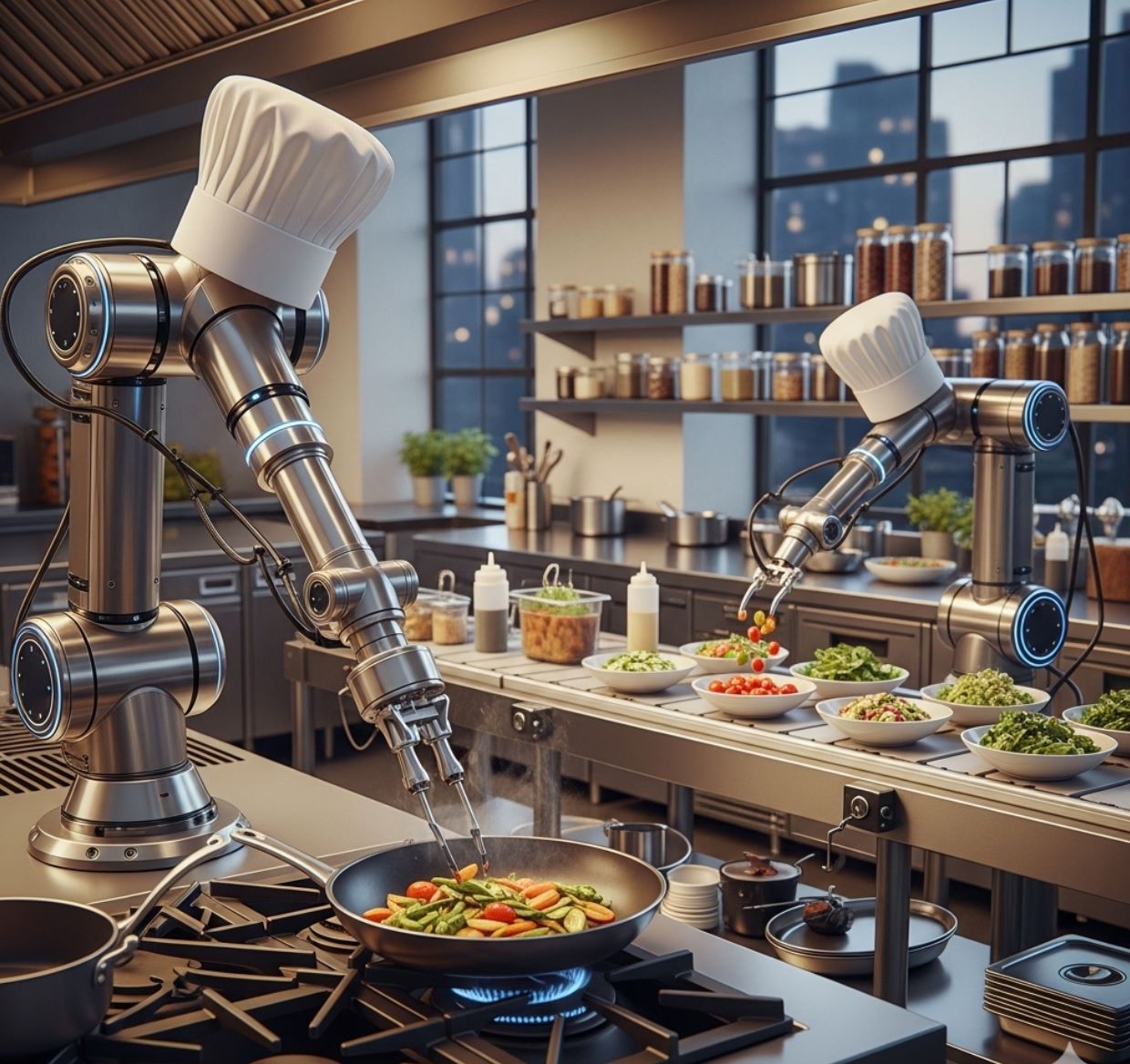
Front-of-House and Service Innovations
AI is transforming guest interactions too. Many restaurants now use AI-driven ordering, self-service kiosks, and even chatbots or voice assistants to handle customers. For example, digital kiosks and mobile apps can present dynamic menus and special offers.
AI Voice Assistants
One prominent instance is White Castle's "Julia" — an AI voice assistant co-developed with Mastercard. Julia takes drive-thru orders using natural language processing, freeing employees to greet guests at the window and handle payments.
The system upsells and ensures order accuracy, aiming for a seamless experience. White Castle executives note that Julia allows staff to engage with customers rather than rattling off orders, creating a more hospitable vibe.
Autonomous Service Robots
Some restaurants deploy autonomous robots for front-of-house service. AI-powered delivery robots (like Bear Robotics' "Penny" or Pudu's bots) can carry trays of food to tables.
AI-equipped robots use onboard cameras and navigation algorithms to shuttle meals through a dining area, letting servers concentrate on customer care. These robots recognize tables and avoid obstacles, helping small teams handle busy service periods without dropping plates.
Personalized Recommendations
Many pizza chains and cafes offer chatbots or app AI that suggest items based on past preferences. AI algorithms analyze a diner's loyalty profile or order history to recommend add-ons (extra fries with burgers, a pastry with coffee, etc.), boosting sales and satisfaction.
Voice AI is also being tested in drive-thrus industry-wide. A Deloitte report notes that voice ordering is an emerging use case: operators are piloting AI systems that take orders by phone or speaker, automating the order-entry process.
When implemented well, these AI tools can reduce wait times and errors. Even food delivery platforms use AI to predict order delays and route drivers, indirectly improving restaurant operations on the customer-facing side. In short, from self-ordering kiosks and mobile apps to voice AIs and service robots, technology is making dining more digital and data-driven.
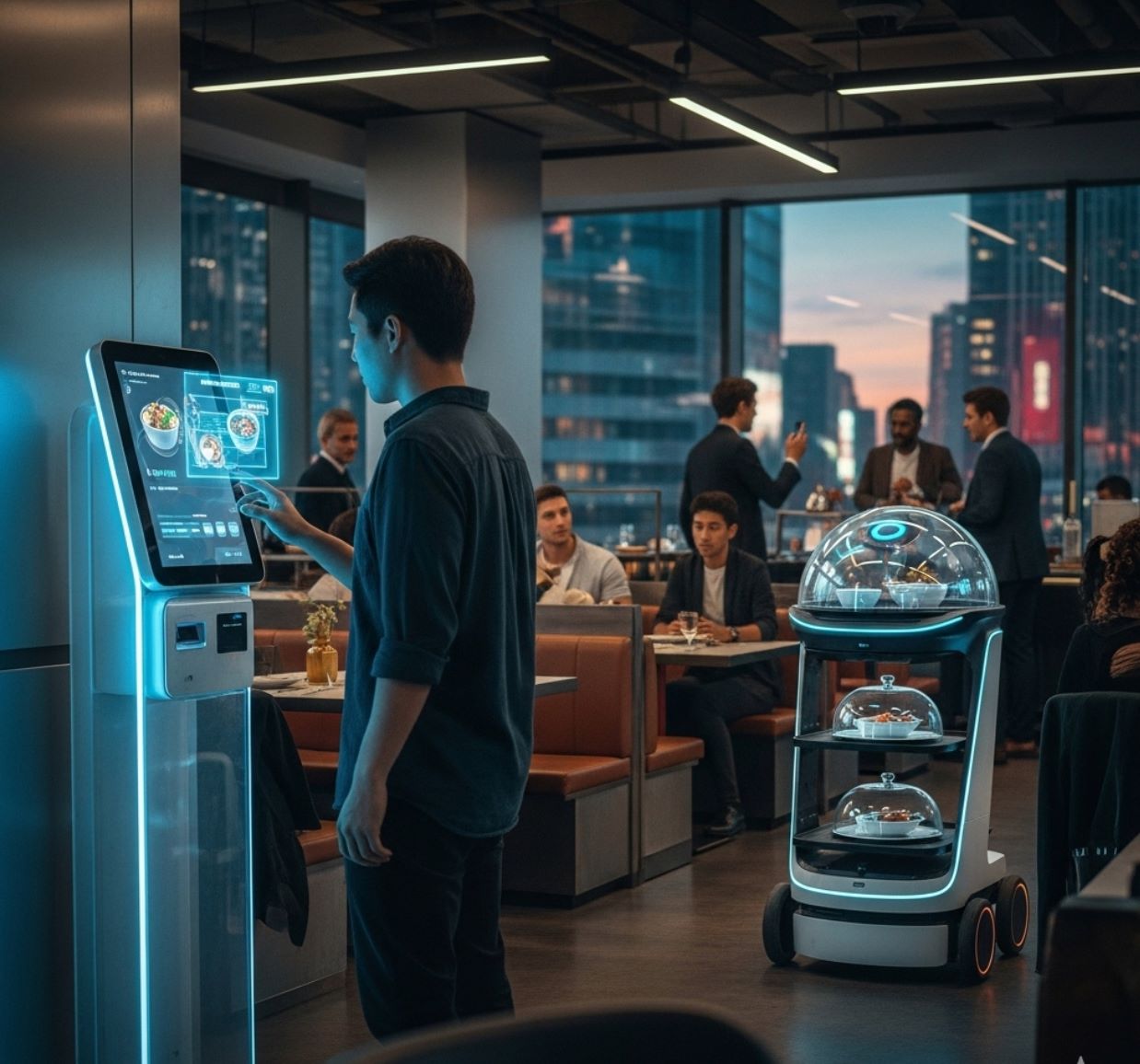
Computer Vision and Quality Control
Computer vision – a branch of AI where cameras and image analysis do the work – is gaining traction in restaurants for quality control and analytics. AI cameras can monitor kitchens and dining rooms, ensuring standards and streamlining service.
Table Management
Food Quality
Portion Control
For example, overhead cameras with AI can track which tables are occupied, how long guests have been waiting, and whether a table has been cleared for cleaning. In one setup, an AI model labels each table area as "EATING," "WAITING," or "CLEANING" in real time.
This allows managers to optimize seating and staffing: if many tables show "WAITING," they know to assign more servers, whereas if "CLEANING" piles up, bussers can be alerted immediately. In busy venues, such real-time vision data can significantly improve turnover and reduce bottlenecks.
A camera mounted above the pizza assembly line inspects every pizza before it goes to the oven and again before boxing. The AI analyzes topping placement, crust color, and overall appearance against brand standards.
— Domino's Pizza Checker System
AI vision is also applied directly to food quality. A notable example is Domino's Pizza Checker. A camera mounted above the pizza assembly line inspects every pizza before it goes to the oven and again before boxing.
The AI analyzes topping placement, crust color, and overall appearance against brand standards. As a result, Domino's reported a roughly 14–15% improvement in product quality (with far fewer mistakes) after deploying this system.
Similarly, large caterers like Compass Group use AI cameras above waste bins to classify discarded food by type and quantity. This data has helped kitchens identify overproduction: one program cut food waste by 30–50% through smarter preparation decisions.
Another chain uses a vision sensor above serving stations to measure portion sizes and refill levels with 95% accuracy, replacing unreliable manual scales.
Beyond food and tables, vision systems can enforce hygiene. While not yet widespread, there are pilot uses of AI to ensure staff wash hands or wear gloves, and to check temperatures of cooked items automatically.
Overall, computer vision gives restaurants an extra set of eyes: AI never tires of checking trays and tables. The result is higher consistency and safety — from flame-grilled steaks to fast-food fries, kitchens can use AI to catch errors before customers do.
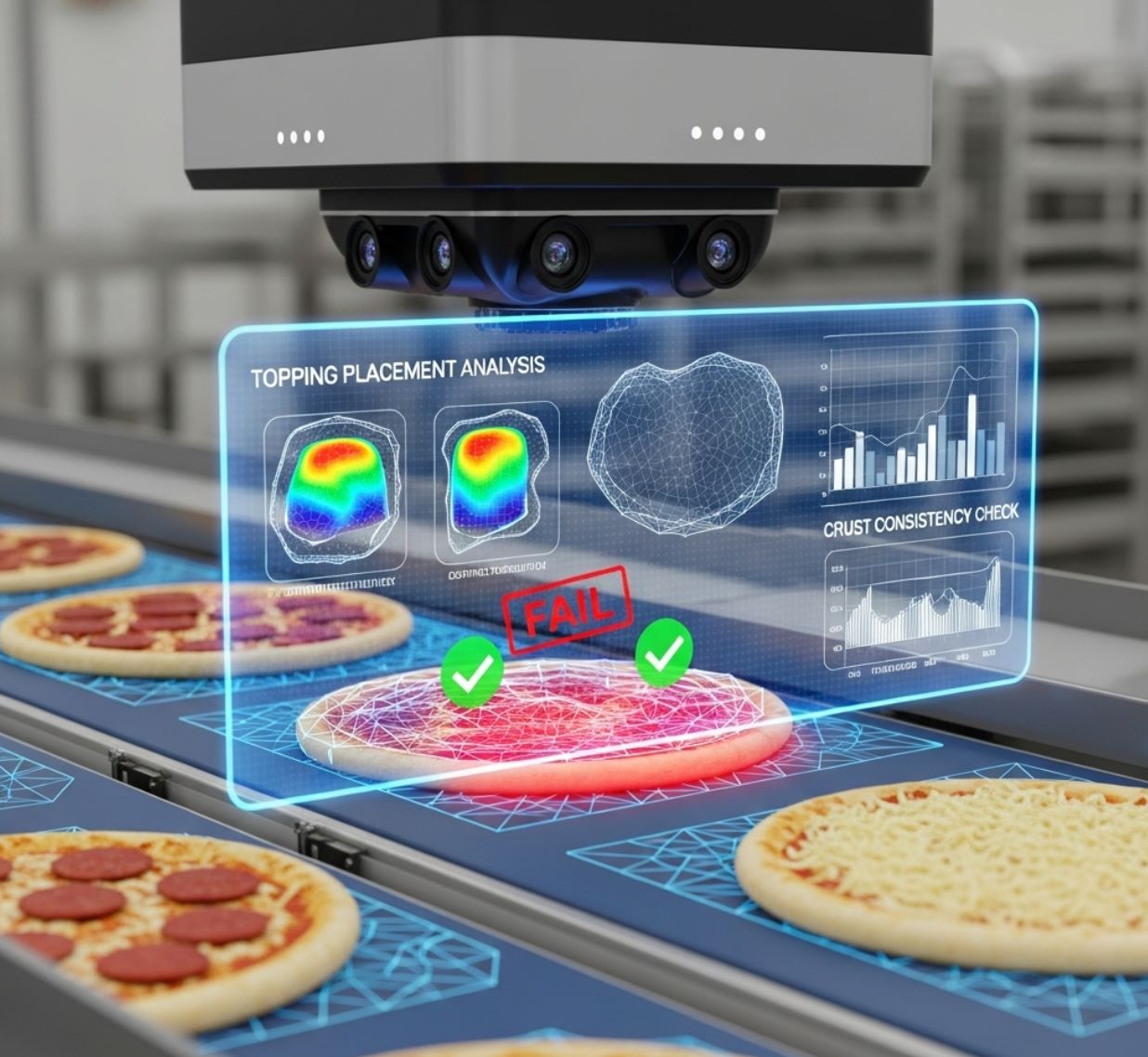
Data Analytics, Staffing, and Decision Support
Underpinning many of these innovations is data analytics. AI tools are embedded in restaurant management software to help owners make smarter decisions. For instance, analytics platforms can crunch point-of-sale and operating data to forecast busy times, suggesting optimal staff schedules.
Smart Scheduling
AI scheduling reduces labor costs by up to 12%
- Demand-based staffing
- Labor law compliance
- Reduced overtime
Menu Engineering
Optimize menu mix and pricing strategies
- Sales pattern analysis
- Dynamic pricing
- Promotion optimization
Global Coordination
Multi-location data unification
- Regional adaptations
- Unified procurement
- Performance comparison
In complex multi-location brands, AI helps managers balance shifts across different outlets and ensure compliance with labor laws. Experts note that AI scheduling can align labor supply with predicted demand, reducing overtime and idle staff. In fact, one review reported organizations using AI scheduling saw up to 12% labor cost reductions from better shift alignment.
Beyond scheduling, AI helps with menu engineering and pricing. By analyzing which items sell best, at what times, and under which promotions, AI can suggest menu mix changes or limited-time offers.
Advanced systems even support dynamic pricing – for example, slightly raising prices during peak hours or happy hours to maximize revenue (though this is more common in hospitality, it is starting to be explored in restaurants). All this is driven by AI analyzing historical sales patterns, customer data, and market trends in real time.
In short, AI-powered software turns raw operations data (sales, inventory, foot traffic) into actionable insights. Restaurant executives can see which locations are underperforming, which items are low-profit, or how marketing campaigns affect orders.
When facing choices like expanding a menu, opening new locations, or investing in new tech, managers can lean on AI forecasts rather than gut feel. A Deloitte survey found many chains believe AI can deepen customer loyalty and improve employee experience in the next wave of adoption.
Globally, these analytics tools help chains coordinate across regions – adjusting for local festivals (e.g. Ramadan in the Middle East or game-day events in the UK) and unifying data for more efficient procurement and staffing.
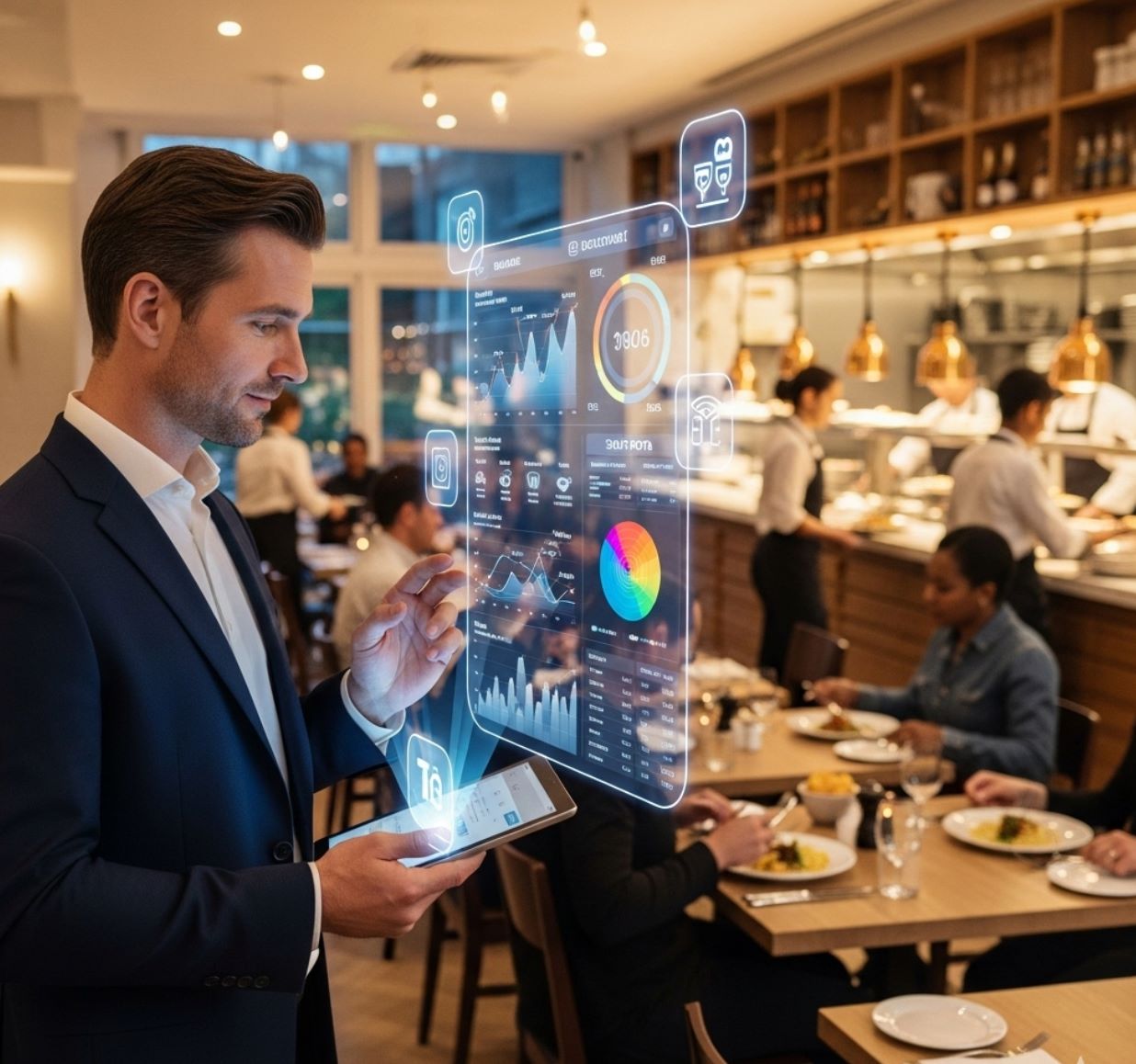
Benefits of AI Adoption
Implementing AI can yield substantial benefits across the restaurant business. Some of the key advantages include:
Greater Efficiency
Cost and Waste Reduction
Improved Customer Experience
Data-Driven Management
Together, these benefits make restaurants more competitive and sustainable. In fact, industry sources report that early adopters of automation often see measurable ROI. QSRs implementing kiosks and online ordering have seen transaction increases (~5%) and profit rises (~8%). Whether a small cafe or large chain, technology can unlock efficiencies that were previously impossible to sustain manually.
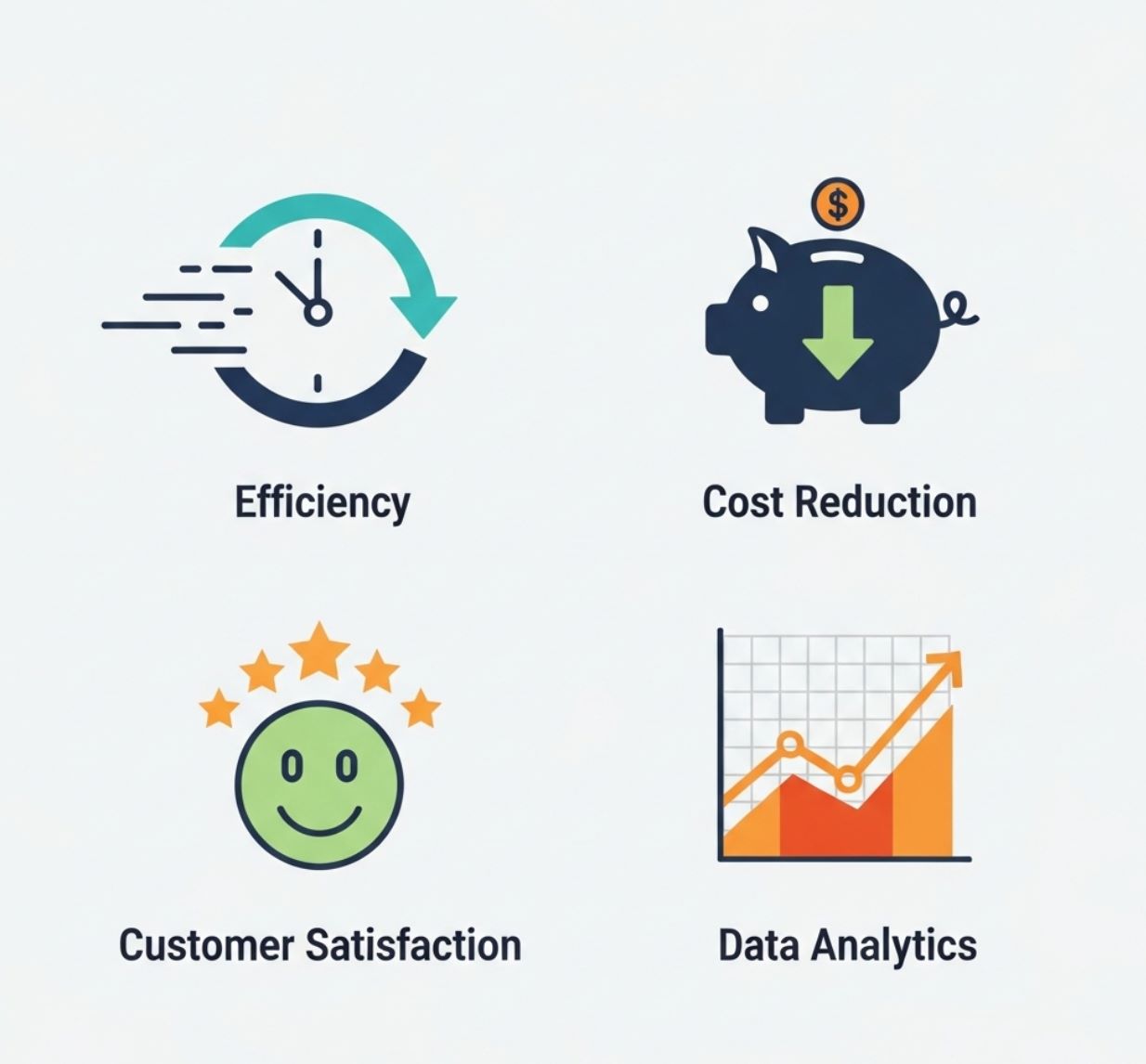
Challenges and Future Outlook
While promising, AI adoption in restaurants comes with challenges. A 2024 survey of global restaurant executives found that many chains are still in the early stages of AI deployment. The first wave of AI (inventory and customer experience) is well underway, but full kitchen automation and menu innovation are still emerging areas.
Talent and Expertise Challenges
About half of surveyed leaders worried about technology risk or lack of AI expertise. Finding talent to implement and maintain AI systems remains a top concern for restaurant executives.
Data Privacy and Security
Data privacy and IP issues surface as systems often rely on customer and operational data. Restaurants need robust cybersecurity measures and governance frameworks.
System Integration
Integration with existing tech is a major hurdle. Restaurants operate dozens of different systems (POS, accounting, reservation platforms, etc.), and AI tools need solid data inputs. Chains need robust networks, sensors, and staff training to make AI function seamlessly.
Future Predictions
Looking ahead, AI's role in restaurants will only grow. Labor shortages and rising costs mean operators will increasingly turn to automation. Advances in robotics and AI models will continue to improve.
- Fully autonomous kitchens in more cuisines
- More personalized marketing and customer experiences
- AI assistants for managers and decision-making
- Enhanced human-AI collaboration models
Most experts agree that AI is a tool to augment human teams – not replace them entirely. The most successful restaurants will be those that blend technology with the human touch, using AI to handle routine work while staff focus on hospitality and creativity.
— Industry Analysis Report
However, most experts agree that AI is a tool to augment human teams – not replace them entirely. The most successful restaurants will be those that blend technology with the human touch, using AI to handle routine work while staff focus on hospitality and creativity.

Conclusion
In summary, AI is reshaping nearly every aspect of restaurant management and kitchen operations around the world. From smart forecasting to robot chefs and data analytics, these innovations aim to make restaurants leaner, safer, and more customer-centric.
As the technology matures, diners and operators alike can expect a faster, fresher, and more personalized dining experience.



